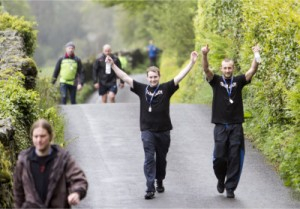
Paul Burns of the Furness Striders has kindly put together a runners' training guide to help you on your way.
The only real training for the walk is walking or running, depending on your chosen method of self-propulsion. If you do 20-30 mile walks regularly during the year then you probably don't need to do anything special to prepare for the K2B. However, we recommend a walk of around half an hour each day: this will make an enormous difference to your general level of fitness and readiness to tackle a longer walk. Don't forget to include some hills because you use different muscles for steep ascents and descents. An alternative approach if you do not walk regularly through the year is to build up with some 10 and 20 mile walks in March and April, leading to a 30-miler by late April. This should see you ready for your 40-miler on the second Saturday in May.
Route familiarity
If you are not familiar with the route, check it on your maps. Spend time studying the maps to get a feel for the route. Where are the hills? Where can you look forward to easy sections where you can stride out? The routes gradient profile shown on the website will assist. The ascent of Red Bank, just past Grasmere, is the steepest section, but the long steady ascent from Lowick up to the Rake Crossroads checkpoint is the toughest part for most people as the afternoon warms up.
Clothing
Early May is one of the most likely times of the year to have settled weather. A final decision on clothing can be left to the day, depending on the conditions, but carry a cagoule or similar to allow for the possibility of rain unless really confident of the days forecast. Also, it's really important for your own safety to wear hi-viz clothing and/or hi-viz armbands for the duration of the event. Weather can change rapidly, with a frosty early morning steadily warming up through the day into a hot afternoon. We have occasionally had heavy cold rain in the afternoon. Sudden rain always causes problems for those without rain gear who does not happen to be close to a support vehicle. If you are not too bothered about designer rainwear, it is useful to carry a bin bag with holes cut for the arms and neck, for emergency cover. This applies especially for children, who will suffer sooner than the adults in the event of moderate rain.
Footwear
Use trainers in which you have full confidence they should be a comfortable fit with room to move the toes. Anything that feels even slightly tight when put on is too small as feet expand during a long walk. Most K2B and C2B walkers prefer trainers to boots. Trainers are lighter and will tire your legs less. If you intend jogging, they are the only option, although you'll get wet feet in the event of rain. Whatever you choose should have been broken in, but should not be so old that the soles are thin or heels worn down. A new pair of insoles will add comfort. Choose your socks carefully. Soft woollen socks are available with extra thickness on the heel and toes for the best cushioning and blister protection. Avoid nylon socks next to the skin because they don't absorb sweat and will make blisters more likely. A change into dry socks around halfway will feel like heaven.